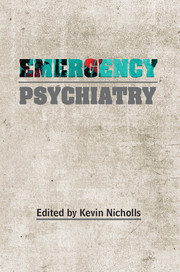Book contents
- Frontmatter
- Contents
- List of contributors
- Acknowledgements
- Preface
- 1 Assessment of suicide risk
- 2 Violence and aggression
- 3 Substance misuse emergencies
- 4 Alcohol and psychiatric emergencies
- 5 Acute psychosis
- 6 Acute side-effects of psychotropic medication
- 7 Emergencies in child and adolescent psychiatry
- 8 The psychiatric intensive care unit
- 9 Safeguarding
- 10 Emergency electroconvulsive therapy
- 11 Life-threatening medical emergencies in a mental health unit
- 12 Emergencies in intellectual disability psychiatry
- 13 Emergencies in older persons’ psychiatry
- 14 Perinatal psychiatric emergencies
- 15 Civilian and military psychological trauma
- 16 Emergencies in liaison psychiatry
- 17 Psychiatric emergencies in deaf people
- 18 Mental health law
- 19 Self-poisoning: aspects of assessment and initial care
- Index
7 - Emergencies in child and adolescent psychiatry
Published online by Cambridge University Press: 01 January 2018
- Frontmatter
- Contents
- List of contributors
- Acknowledgements
- Preface
- 1 Assessment of suicide risk
- 2 Violence and aggression
- 3 Substance misuse emergencies
- 4 Alcohol and psychiatric emergencies
- 5 Acute psychosis
- 6 Acute side-effects of psychotropic medication
- 7 Emergencies in child and adolescent psychiatry
- 8 The psychiatric intensive care unit
- 9 Safeguarding
- 10 Emergency electroconvulsive therapy
- 11 Life-threatening medical emergencies in a mental health unit
- 12 Emergencies in intellectual disability psychiatry
- 13 Emergencies in older persons’ psychiatry
- 14 Perinatal psychiatric emergencies
- 15 Civilian and military psychological trauma
- 16 Emergencies in liaison psychiatry
- 17 Psychiatric emergencies in deaf people
- 18 Mental health law
- 19 Self-poisoning: aspects of assessment and initial care
- Index
Summary
This chapter will discuss the types of psychiatric emergencies that commonly present to child and adolescent mental health services (CAMHS) in the UK, paying particular attention to community tier 2/3 CAMHS (Box 7.1). We have tried to adopt a systems approach to the assessment and management of such emergencies, which may variously involve input in the community (including the involvement of crisis-resolution or hometreatment teams), short-term admissions to the local paediatric ward or admissions to regional tier 4 child and adolescent psychiatric units, as well as the involvement of other agencies, such as education, social care and the police.
From the outset, we would like to point out that this chapter is not a comprehensive text on common child and adolescent psychiatric conditions. Indeed, a basic knowledge of these conditions is presumed of the reader: the knowledge expected of a medical graduate. The uninitiated reader is referred to a number of excellent child and adolescent psychiatry textbooks currently available (Goodman & Scott, 2005; Turk et al, 2007; Rutter et al, 2008). Although this chapter is primarily aimed at psychiatric trainees working in the UK (especially higher specialty trainees), we hope it might also be of some use to general practitioners (GPs), GP trainees, doctors working in emergency departments and paediatricians. For this last group, we hope that they might gain a greater appreciation of how CAMHS clinicians approach and manage emergency assessments.
In this chapter, we will draw out some of the themes that we, as consultant child and adolescent psychiatrists in a busy urban CAMHS, face on a regular basis when managing emergency presentations. We will begin with a discussion on what constitutes an emergency in CAMHS. We will then examine the different pathways in which emergencies might become known to us, and how the clinician's response might vary depending on the pathway. We shall look at the different systems in which any child or adolescent presenting with a mental health emergency will invariably be situated, systems that present their own problems and issues but also potential for facilitating change for the patient. Next, the assessment process will be described, taking into account these different systems, which will in turn inform any management decision.
- Type
- Chapter
- Information
- Emergency Psychiatry , pp. 110 - 126Publisher: Royal College of PsychiatristsPrint publication year: 2015

